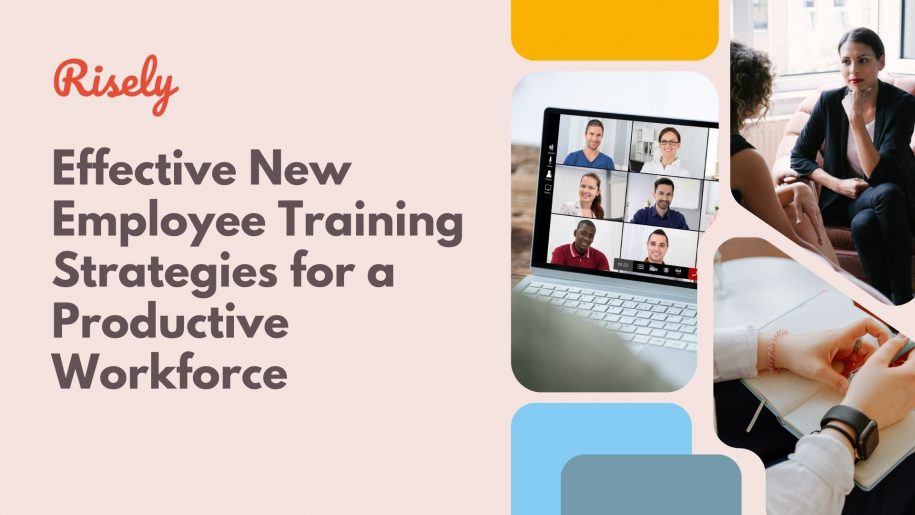Effective New Employee Training Strategies for a Productive Workforce
As teams thrive on the shoulders of their talented workforce, investing in comprehensive and effective onboarding programs becomes increasingly vital. Welcoming new team members to a team is not merely about handing them a desk and a company handbook. Instead, it is an opportunity to pave the way for their success, ensuring they hit the ground running and become valuable contributors to the company’s growth. This blog will delve into the importance of well-designed new employee training programs and explore the strategies and benefits they bring to the individual and the team. We understand that onboarding is more than just a one-time event; it is the foundation for a fulfilling and successful career.Table of Contents
Why is new employee training important?
New employee training is of utmost importance for teams as it plays a crucial role in shaping the success and productivity of their workforce. A well-designed and comprehensive training program ensures that new hires have the necessary knowledge, skills, and resources to excel in their roles, making them valuable assets to the company from the outset. Firstly, effective new employee training facilitates a seamless onboarding process. It helps new hires quickly assimilate into the company culture, understand the team’s values and goals, and feel welcomed as part of the team. Employees who feel supported and connected to the team are more likely to engage actively and remain committed to their work. Secondly, training ensures job proficiency. New employees may possess some basic skills, but training gives them a deeper understanding of their roles and responsibilities. It enables them to learn about the company’s products, services, and processes, ensuring that they can perform their duties efficiently and with confidence. Thirdly, employee training boosts productivity. Employees with the necessary knowledge and skills can work more effectively, complete tasks efficiently, and produce higher-quality output. This, in turn, positively impacts overall productivity and success. Moreover, training contributes to employee retention and engagement. Investing in employee development demonstrates the company’s commitment to its growth and well-being. Employees who receive adequate training are more likely to be satisfied in their roles, feel valued by the team, and stay with the company for the long term.Grab the free training and development plan template by Risely!
Refocus on core elements for effective training programs with Risely.
Strategies for new employee training
Designing effective new employee training strategies is essential for ensuring a smooth onboarding process and setting the stage for employee success within the team. Here are detailed strategies for new employee training:- Comprehensive onboarding program: Develop a well-structured onboarding program that spans the first few weeks of the new employee’s tenure. The program should include orientation sessions, introductions to key team members, and an overview of the company’s mission, vision, and values. This phase aims to help new hires understand the team’s culture and establish a sense of belonging.
- Clear learning objectives: Define specific learning objectives for the training program. Identify the skills, knowledge, and competencies new employees should acquire by the end of their training. Having clear goals will guide the training content and assessment process.
- Customization for roles: Tailor the training to suit different job roles and departments within the team. Different positions may require specific skills or knowledge, so providing role-specific training ensures new employees are well-prepared for their responsibilities.
- Blended learning approach: Utilize a blended learning approach that combines various training methods. This can include instructor-led sessions, hands-on workshops, e-learning modules, videos, and group activities. A mix of learning methods caters to different learning styles and enhances engagement.
- Mentorship and buddy system: Pair new employees with experienced mentors or buddies who can guide, answer questions, and offer support during onboarding. This fosters a sense of camaraderie and enables new employees to seek help when needed.
- Interactive training methods: Incorporate interactive training methods to keep new employees engaged and actively involved in learning. Activities like role-playing, simulations, and problem-solving exercises help reinforce learning and make the training more enjoyable.
- Cross-departmental training: Offer opportunities for new employees to interact with and learn from different departments. This cross-departmental exposure promotes collaboration, encourages a broader understanding of the organization, and fosters teamwork.
- Encourage questions and curiosity: Create a supportive environment where new employees feel comfortable asking questions and seeking clarification. Encourage a culture of curiosity, as it helps new hires grasp concepts more effectively and enhances problem-solving skills.
- Follow-up and support: Provide ongoing support beyond the initial training period. Check in with new employees regularly to address concerns and ensure they have the resources to succeed. Offer additional training or coaching as necessary.

What to avoid in the new employee training program?
When designing a new employee training program, it’s crucial to avoid certain pitfalls that can hinder the effectiveness of the training and negatively impact the onboarding experience. Here are some things to avoid in a new employee training program:- Information overload: Avoid overwhelming new employees with excessive information all at once. Instead, prioritize essential knowledge and skills, and provide information in manageable chunks. A gradual learning approach helps retain information better.
- Lack of structure: Don’t leave the training program without a clear structure or timeline. A well-organized and structured training plan ensures that new hires know what to expect and understand the sequence of training modules.
- Neglecting individual needs: Avoid treating all new hires as a homogenous group. People come with different backgrounds, skills, and learning preferences. Tailor the training to accommodate individual needs, ensuring everyone has an equal opportunity to succeed.
- Insufficient interactivity: Passive training methods involving only lectures or reading material can lead to disengagement. Incorporate interactive elements such as hands-on activities, group discussions, and simulations to keep participants engaged and actively learning.
- Ignoring feedback: Feedback from new employees is invaluable in improving the training program. Encourage feedback throughout the training process and use it to refine and enhance the program for future hires.
- Not aligning with job requirements: Ensure the training content aligns closely with job requirements and responsibilities. Irrelevant or outdated information can confuse new employees and waste valuable training time.
- Rushing through training: Avoid rushing through the training process to expedite new employees’ readiness. Give them sufficient time to absorb and apply the information effectively, which leads to better job performance and productivity in the long run.
- Ignoring company culture: Don’t neglect to introduce new hires to the company’s culture, values, and mission. Understanding the team’s ethos is essential for fostering a sense of belonging and alignment with the company’s goals.
- Not measuring training effectiveness: Avoid launching a training program without mechanisms to assess its effectiveness. Set clear metrics and evaluate the program’s impact on employee performance, engagement, and retention.
Other Interesting Reads
Tips for managers creating new employee training programs
Creating an effective new employee training program is a crucial responsibility for managers. Here are some essential tips to help managers design and implement successful training programs:- Understand job requirements: Before developing the training program, ensure a clear understanding of the job roles and responsibilities of the new employees. This knowledge will help tailor the training content to meet specific job requirements.
- Set clear learning objectives: Define clear and measurable learning objectives for the training program. Outline what skills, knowledge, and competencies new employees should acquire by the end of their training.
- Identify training needs: Conduct a needs assessment to identify the training needs of new employees. This assessment should consider the technical and soft skills required for their roles.
- Create a structured plan: Develop a well-structured training plan with a logical sequence of topics and activities. Organize the training content to allow new hires to build on their knowledge progressively.
- Include real-world scenarios: Use real-world scenarios and case studies relevant to the company’s operations. This practical approach allows new employees to apply their learning to work situations.
- Promote Continuous Learning: Encourage a culture of continuous learning within the organization. Highlight the importance of ongoing development and provide resources for employees to pursue further training or education.
- Adapt to remote workforce: If the team has remote employees, ensure the training program is adaptable to remote work settings. Utilize online tools and virtual training platforms to facilitate remote learning.
- Cultivate a supportive environment: Create a supportive and welcoming environment for new employees during training. Ensure that they feel comfortable asking questions and seeking help when needed.
- Establish a clear progression path: Outline a path for new employees after the initial training. Provide information on opportunities for growth, promotions, or skill development within the organization.
- Celebrate training milestones: Recognize and celebrate the successful completion of training milestones. Acknowledge the achievements of new employees, which boosts morale and motivation.
Conclusion
In conclusion, we have explored the transformative impact of effective new employee training. The onboarding journey extends beyond the initial days of orientation; it is a strategic investment laying the groundwork for a thriving and engaged workforce. A well-designed training program goes beyond just equipping new hires with the necessary skills; it embraces company culture, fosters a sense of belonging, and empowers employees to reach their full potential. By prioritizing clear learning objectives, interactive training methods, and continuous support, organizations can ensure that their new team members are set up for success right from day one.Grab the free training and development plan template by Risely!
Refocus on core elements for effective training programs with Risely.
Other Related Blogs
Performance Management Training: Empowering Managers To Manage Better
Performance Management Training: Empowering Managers To Manage Better Remember that feeling of dread when you knew performance review season was rolling around? Yeah, us, too. For many employees, performance reviews…
Manager Development Goals And How To Reach Them: Opportunities And Areas To Focus On
Manager Development Goals And How To Reach Them: Opportunities And Areas To Focus On You’ve meticulously crafted a development program for your high-potential employees, but their managers just aren’t on…
Leader Competence: The Cornerstone of Effective Leadership Development
Leader Competence: The Cornerstone of Effective Leadership Development Imagine you’re leading a talented team, but somehow, projects are stalling, and motivation seems slipping. You see the potential in your people,…
Confused by L&D Metrics? Here’s How to Focus on What Matters
Confused by L&D Metrics? Here’s How to Focus on What Matters You’ve undoubtedly witnessed companies celebrating a record number of employees completing leadership training programs. Champagne toasts erupt, press releases…


